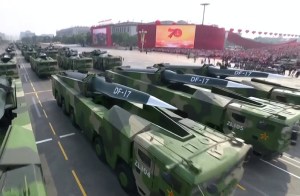Calls are rising for China close the gap with the United States in laser weapon development, a capacity viewed as the future of missile defense and counter-satellite warfare.
This month, South China Morning Post (SCMP) reported that China needs to emphasize the development of feasible laser weapons, an area where it is perceived to lag behind the US.
Compared to kinetic energy weapons, directed-energy weapons such as lasers have the advantage of instantaneous hits, pinpoint accuracy, scalable power requirements and negligible cost per shot.
Their drawbacks, on the other hand, include size and bulk, substantial power requirements, weakening power over distance, and sensitivity to weather conditions.
Beijing-based researcher Zhou Chenming was quoted by SCMP saying China is good at making smaller laser weapons, but lacks larger models that can intercept bigger targets like missiles or be installed on warships or airplanes.
Song Zhongping, a former People’s Liberation Army (PLA) instructor, mentioned that China must invest more in directed energy weapons, as they are an essential part of modern technology that must be applied on the battlefield, according to the same SCMP report.
Larry Wortzel notes in the 2017 book “The Logic of Irregular War: Asymmetry and America’s Adversaries” that since the PLA perceives its technology as lagging the US, it is constantly trying to develop “magic weapons” including laser systems that will give it an asymmetric advantage.
Wortzel notes that China and the US see each other as engaged in a critical contest for military deterrence and supremacy, accelerating both sides’ development of their respective military technologies.
Asia Times noted last January that the rapid development of hypersonic weapons may be driving the rising investment and accelerating the development of laser weapons among leading military powers. Hypersonic weapons fly at Mach 5 or faster to evade current and planned missile defenses.

While Asia Times noted this month that China’s successful mid-course missile intercept test aims to strengthen its defenses against US intercontinental ballistic missiles (ICBM) and intermediate-range ballistic missiles (IRBM) in the Pacific, the capacity may not be sufficient against hypersonic weapons.
Current missile defense systems such as the US Terminal High Altitude Area Defense (THAAD) and Patriot PAC-3, and China’s HQ-19 may be ineffective against hypersonic threats as the high cost per interceptor missile makes them potentially unfeasible as long-term options.
Oskar Glaese notes in a June 2022 article for The Diplomat that ground-based laser systems face significant challenges such as the high levels of power needed to affect targets in orbit, accuracy at great distances and ability to assess damage against targets.
Glaese contrasts these with the possible advantages of space-based laser weapons, noting the smaller distances between orbiting satellites and the lack of atmospheric distortion that affects laser range and power, with such systems capable of being deployed defensively against anti-satellite attacks.
However, he also says that the main challenge in developing space-based laser weapons is developing a power source that is compact and strong enough to be mounted on a satellite.
Although America’s hypersonic weapons program has suffered many test failures and development setbacks, the US is still pressing on with a “test often, fail often, learn quickly” approach while leveraging technological assistance from its closest allies.
This month, Asia Times reported on the US decision to scrap its troubled Air-Launched Rapid Response Weapon (ARRW) project in favor of the Hypersonic Attack Cruise Missile (HACM) due to the former’s repeated test failures.
In addition, the ARRW may be unreliable due to its overly complicated two-part glide vehicle booster design compared to the scramjet-powered HACM.
Australia may play a critical role in providing scramjet technology for the HACM, as Australian aerospace firm Hypersonix demonstrated its 3D-printed scramjet engine to US defense officials in March 2022. It has several advantages over US models which allow it to be printed in three weeks using special alloys.
That cooperative approach under the AUKUS framework may address the shortcomings of the US hypersonic weapons program, which include poor weapons design and fabrication, poor test planning and management, gaps in preflight tests, lack of rigorous government oversight and a tendency to trivialize costly failures.
Apart from defending against hypersonic weapons, China may be developing lasers for anti-satellite purposes to destroy US space-based missile defenses.
Last March, Asia Times noted that China has also developed a satellite-mountable solid-state pulse laser capable of generating a megawatt laser light and firing 100 times per second for a half hour without overheating. That laser is powerful enough to dazzle or permanently blind satellite cameras and can permanently blind human beings or vaporize target surfaces.

China may deploy the weapon against next-generation US military and dual-use satellites. Asia Times reported last July that the US had announced plans to spend US$1.3 billion to develop advanced satellites to track hypersonic weapons and change the fundamental architecture of its space-based missile defenses.
Present such US defenses rely on a few large, expensive satellites that stay in orbit for 15 years. That system is also vulnerable to attack, as it lacks defensive capabilities and is locked in predictable orbits.
The US plans to replace that architecture with a two-tiered system operating in low-earth (LEO) and medium-earth (MEO) orbits at 10,000 to 20,000 kilometers using cheaper satellites that can be replaced every five years.

